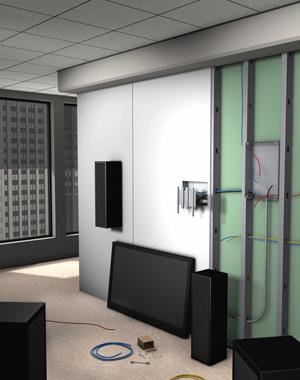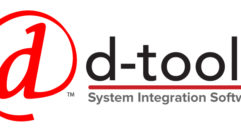

Unfinished Business: The Importance of Risk Management
Squeezed by low equipment margins, a shortage of qualified labor, and high operating costs, general contractors continue to face challenges in the construction industry?which often trickle down to subcontractors, including systems integrators, who often take on more work than they can handle, leading to unsatisfied clients and lost business.
Squeezed by low equipment margins, a shortage of qualified labor, and high operating costs, general contractors continue to face challenges in the construction industry—which often trickle down to subcontractors, including systems integrators, who often take on more work than they can handle, leading to unsatisfied clients and lost business. With construction lawsuits on the rise, savvy integrators are taking a proactive approach by implementing risk management strategies, such as proper bonding and insurance coverage, to protect their businesses.
Risk management planning has become more important than ever because AV professionals face more liability in today’s business climate, says Teresa Martin, vice president/producer for Lockton Insurance, an independent insurance brokerage/risk management services firm in Kansas City, Mo., with offices in 16 cities. “More jobs are fast-track projects, and the contracts have become more complex,” she says. “In today’s environment, more risk is shifting from the owner to the general contractor to the subs.”
This increased level of risk has escalated the number of lawsuits in the AV industry, says Chuck Wilson, executive director of Cedar Rapids, Iowa–based National Systems Contractors Association (NSCA). “Sadly, litigation is quite common on a large construction project,” Wilson says. “With so many parties involved, it’s a breeding ground for something to go wrong. There’s a potential for injury, and all sorts of things can happen beyond the AV integrator’s control.”
If a contractor defaults on a loan, fails to make a payment, or files liens that slow down a project, for example, an owner can stop payment to the entire construction team, including the systems integrator. Litigation filed against AV professionals runs the gamut from a breach of contract to malpractice, says Doug Weems, chair of litigation and the dispute resolution group for Spencer Fane Britt & Browne, LLP, a law firm with offices in Kansas City, Mo.; Overland Park, Kan.; Omaha, Neb.; and St. Louis.
STRATEGIES TO REDUCE LIABILITIES
By their very nature, integrators are often more focused on technology than on construction law and business basics, Wilson says. If they want to spend more time on the jobsite than in the courtroom, however, they need to brush up on a few ways to minimize liabilities. Among them, five golden rules:
1. Don’t overlook documentation. The main way subcontractors, including systems integrators, get into trouble on a construction project is by not obtaining sufficient documentation, says Nick Badgerow, a partner in Spencer Fane Britt & Browne and an American Arbitration Association construction arbitrator.
“Too many times, oral changes are made without a written confirmation,” he says. “People in the field are hesitant to ask for written change orders, believing it will imply a lack of trust, but when the job fails, memories will fail, too.”
It’s a dangerous practice to accept contracts as-is, without reading them, or accept oral change orders because it’s difficult to prove anything when going to court with oral evidence, Badgerow says. To avoid falling into this trap, he advises integrators to require written, signed change orders—or, at the very least, initialize any changes that are made to the drawings or specs on the jobsite. Integrators should also train field and contract administration personnel to obtain or prepare written verification in every case of a departure from the contract, plans, or specifications.
“Even if the document is not a formal change order under the contract, at least a written verification or confirmation of a change request will later help to justify a departure from the contract documents,” he says.
2. Get along with the construction team. Because any changes to the design of a building can directly affect an AV system, it’s crucial for integrators to forge a close relationship with the architect, general contractor, and other trades to keep up with any modifications. Staying on positive terms with the rest of the team can significantly reduce the risk of being hit with a lawsuit, says David Seiter, a partner in Spencer Fane Britt & Browne. As with most endeavors in life, he says open communication and a friendly working environment are also keys to success.
3. Decide who should own the intellectual property. By keeping a clear line of communication open with building owners, integrators can make it clear whether or not they intend to hand over the software, programming, and/or coding, or whether they plan to maintain control over the system. Many times the source code isn’t for sale at all, Wilson says.
“Oftentimes, the building owner feels like he/she paid for the building and should have total access to the source code and original program,” Wilson says. “Often in our world, there is confusion over the complex nature of our products and services. This can lead to a misunderstanding of the owner’s expectations regarding what is included in the scope of work.”
On every job his company works on, Mario Maltese, owner of Audio Video Resources in Williston Park, N.Y., makes it common practice to transfer files to the owner upon completion of a project. “They paid for our time to program it, and we think they should own it,” says Maltese, CTS-I, CTS-D, who specializes in design/build, testing, and verification. “A lot of integrators like to keep it close to their vest and keep the owners in a bit of a hostage situation. We’ve gotten a lot of work from customers whose integrators have told them that they have to go through them to upgrade the control system. They then pay us to reprogram the whole thing.”
4. Set realistic expectations. Along with getting tangled up in issues of intellectual property, systems integrators can also set themselves up for failure by taking on more than they can handle or not having the expertise, test equipment, or skill set to manage multiple projects of a large scope, Wilson says.
Brian Huff, CTS-D, a supervisory consultant at Acentech in Philadelphia, sees this all too often on construction projects. In fact, he says engineering and project management aren’t done the way they once were. For example, a contractor puts an inexperienced or under-qualified project manager on a job or uses schematic bid documents to build from rather than producing professional shop drawings.
The AV industry has lost a lot of good companies due to poor judgment, says Wilson. However, he maintains that integrators have become smarter about which projects they accept. By using scheduling software and management systems, they’re now able to analyze backlog and track cash flow.
5. Get the job done right and on time. Most of the time, systems integrators who finish a job and meet the owner’s and contractor’s expectations won’t find themselves embroiled in a lawsuit, Wilson says.
Maltese’s experience is a case in point. By focusing on quality control and customer service, he hasn’t faced lawsuit in his 40 years in the business and has had only three claims on his 7-year-old business’ $2 million policy. The former cofounder of Tamco Systems and senior faculty member at the Infocomm International Academy attributes Audio Video Resources’ lack of litigation to its emphasis on customer service. “If you have a strict focus on quality and pleasing the customer, your risk is almost nil,” he says.
By following these risk management strategies, integrators can travel down the road to profitability rather than toward litigation. However, another safety measure that is often put into place on construction projects is bonding, which comes in many different types including bid, performance, or payment.
BRUSHING UP ON BONDING
If integrators are chasing large public construction jobs, it’s common for general contractors and owners to require a bond. By definition, a surety bond issued on behalf of a second party is a guarantee to a third party that an obligation will be fulfilled on a project. For example, bonding provides protection if a company goes out of business, or a systems integrator falls behind schedule/goes over budget.
Increasingly, integrators are being asked to provide bonds, says Stuart Haker, risk management advisor for NSCA SystemsPlus Insurance Solution. Project owners often desire assurance that the contractor selected will be able to complete the job and perform quality work, he says.
Bond approval often hinges on the integrator’s financial stability, character, and capacity to complete the job, Haker adds. The company’s bonding rate also depends on the integrator’s ability to perform, whether or not it’s ever had a project go wrong, and how long it’s been in the business.
SPL Integrated Solutions in Columbia, Md., often finds that bonds are required on most of its large public projects. “The bonds aren’t in place to protect us, but to protect the owner to make sure the job gets done and for the price that we were awarded the contract,” says Jay Paul, vice president, quality assurance.
Although bonding is key, it’s not the only way to manage risk on a project. Insurance is also important.
CONSIDERING COVERAGE
Insurance functions as a risk transfer mechanism for integrators. The amount of insurance a company needs depends on the size of the company, as well as the requirements of the contract on the job. A typical insurance package for an integrator often includes general liability, auto liability, workers compensation, property coverage, equipment coverage, and umbrella/excess liability, Martin says. However, other kinds may be necessary, such as errors and omissions insurance.
When it comes to determining how much insurance is enough, you need to determine how much risk you’re willing to bear, Badgerow says. “Insurance is necessary because it’s a way of sharing liability for a loss that might occur,” he says. “There’s not a rule of thumb of X amount compared to the amount of the contract.”
Before starting a project, Martin advises integrators to take contracts to their insurance broker to determine if they have the proper insurance in place. It’s also a good idea to review the amount of liability with their attorney in advance. As a best practice, integrators should also buy insurance on an annual basis to cover their entire business operation, she says.
TIPS FOR AVOIDING A LAWSUIT
1. Read documents carefully before you sign them. If you don’t understand the contract, take it to someone who can help you. Never sign a contract without understanding it, says Nick Badgerow, a partner with Spencer Fane Britt & Browne, a law firm with offices in Kansas City, Mo.
2. Understand the scope of work. Before you show up on a jobsite, make sure you know exactly what is expected from your company. Don’t take shortcuts when defining the scope of work. Also, be aware that different members of a construction team may have different expectations as to how a product works and who is responsible for installing it, so make it clear in the contract, says Dave Seiter of Spencer Fane Britt & Browne.
3. Set a clear line of authority. Many times on construction projects, integrators don’t know who their boss is, and who can make the call on a change, Badgerow says. “They answer to a lot of different masters at one time, and they can get into trouble by following one and not the other,” he says.
4. Emphasize safety. Integrators need to have regular safety meetings and take safety seriously, says Chuck Wilson, executive director of the National Systems Contractors Association.
5. Test and verify your system. Integrators need to make sure the system they installed is fully operational before they leave the jobsite. Commissioning systems is critical to avoiding unhappy customers.
While most integrators carry a general liability insurance policy of about $2 million, Wilson encourages integrators to closely look through the front end of the project specifications to determine if a sum above general liability is required. Integrators often have to pick up additional insurance up to $5 million, he says. He also recommends that design/build integrators include errors and omissions insurance in case there’s any confusion about what is or isn’t included, or in case something doesn’t work according to design. According to Haker, contractors need to be aware that there is no coverage for damages arising from their work unless they buy an errors and omissions policy to eliminate that gap in coverage.
For the last three years, Verrex Corp., an audiovisual, videoconference, and sound systems integrator in Mountainside, N.J., has carried $1 million in general liability and $1 million for errors and omissions. Last year, the family-owned company increased its umbrella from $6 million to $10 million, says controller Nancy Bowe.
Similarly, SPL Integrated Solutions carries both errors and omissions and liability insurance, Paul says. “Typically, many of our clients will dictate the amount of liability insurance that we carry,” he says. “It will be called for in bids or by the companies doing business, and is typically not less than $5 million.”
The insurance carried by system integrators varies greatly by each integrator’s situation. There is often a tendency to allow contract requirements to dictate the type and amount of insurance carried, but this isn’t always the best approach, Haker says.
“Historically, insurance has been a lousy investment,” he says. “Focus your efforts on managing your risk at the lowest cost.”
Haker advises integrators to focus on their financial ability to assume the risk by themselves and buy insurance where there’s the potential for losses to exceed the credit capacity of their firm. This will decrease premiums and focus dollars on areas in which there is the greatest financial risk, he says.
As anyone who’s ever worked on a construction project knows, things can and will go wrong. And when they do, integrators run the risk of getting hit with a pile of change orders and even a lawsuit. By brushing up on construction law and business basics, however, they can turn a risky business into a profitable venture.
Amy Florence Fischbach is a freelance writer based in Overland Park, Kan. She can be reached at [email protected].










